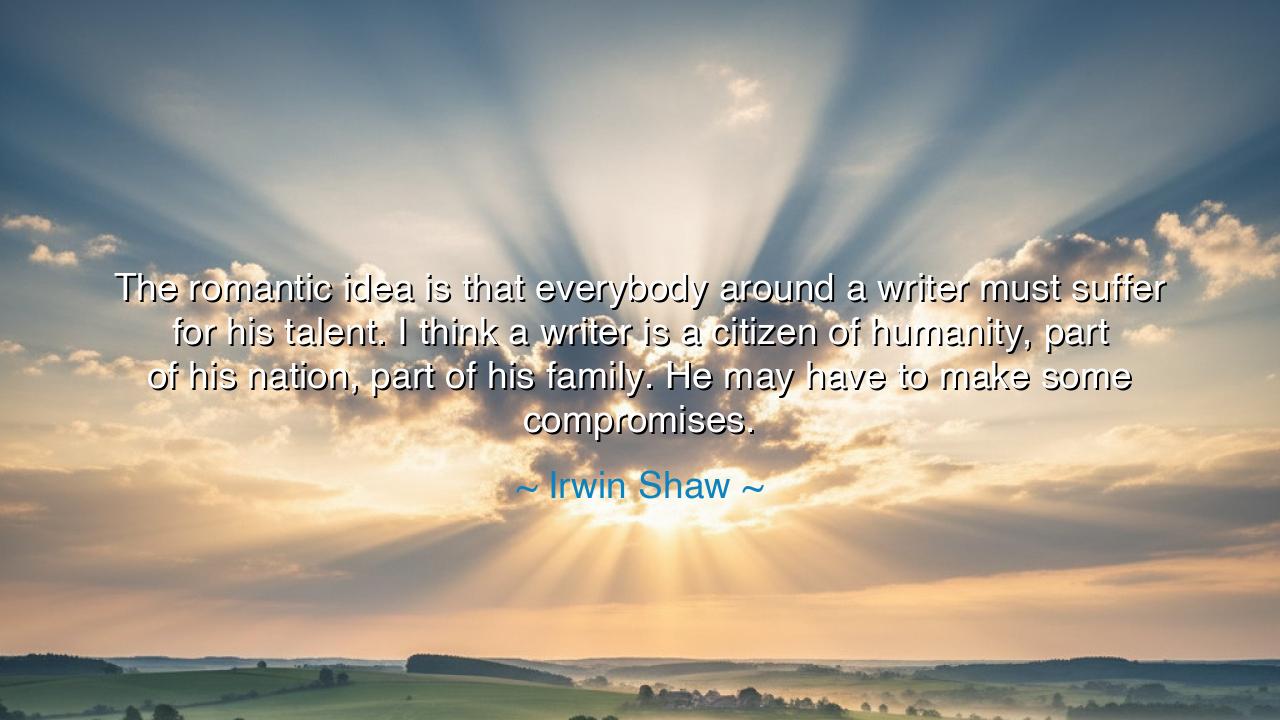
The romantic idea is that everybody around a writer must suffer
The romantic idea is that everybody around a writer must suffer for his talent. I think a writer is a citizen of humanity, part of his nation, part of his family. He may have to make some compromises.






Listen closely, O seekers of wisdom, to the words of Irwin Shaw, who speaks with clarity and understanding about the true nature of the writer’s life: "The romantic idea is that everybody around a writer must suffer for his talent. I think a writer is a citizen of humanity, part of his nation, part of his family. He may have to make some compromises." In these words, Shaw challenges the idealized notion of the artist, often glorified in myth and culture as one who must live in isolation, sacrificing the happiness and well-being of those around them in the name of art. Instead, he reminds us that the writer, like any other person, is part of a larger community, connected to others by the bonds of family, society, and shared human experience. Talent is not a reason to abandon one’s responsibilities or connections but should be nurtured within the context of a life that includes compromise and balance.
In the ancient world, many of the great writers and poets were seen as isolated figures, dedicated entirely to their craft. Think of Homer, whose epic tales like the Iliad and the Odyssey shaped the foundation of Western literature. Homer, though perhaps more myth than man, is often imagined as a wandering figure—blind, homeless, and dedicated to storytelling above all else. His writing became an act of devotion to the gods and the muses, and one could easily imagine the sacrifices made by those around him, whether family, friends, or community. Yet, Homer’s legacy reminds us that the tension between artistic expression and the needs of the community is not new. His stories, though full of heroic feats, also reflect the importance of community and the sacrifices made by individuals for the greater good of those around them.
Shaw’s words, however, offer a more modern view—a rejection of the romantic myth that the artist must be a tortured soul, disconnected from the very people who support and nurture them. The idea that a writer must live in isolation, disconnected from the world, as if their talent were a burden that others must bear, is a view that has been romanticized throughout history. Think of the tragic tale of Vincent van Gogh, whose genius was not fully recognized during his lifetime. Van Gogh’s life was full of personal struggles, and his art—though revolutionary—did not bring him the joy or recognition he sought. His story fits the classic image of the artist suffering for their vision, but is this truly the path every artist must take? Shaw suggests that this suffering is not inherent to the artistic journey but is a romanticized notion, one that we must move beyond if we are to live fulfilling and connected lives.
Consider the life of Leo Tolstoy, whose epic novels War and Peace and Anna Karenina delved deeply into the human experience. Tolstoy’s own journey, however, was marked by a desire to live a more spiritual and community-oriented life. As he grew older, he struggled with the tension between his role as a writer and his responsibilities as a father and husband. Like Shaw, Tolstoy understood that the artist must remain engaged with the world, with the very people who help shape their experiences. Writing, for Tolstoy, was not about the artist’s isolation but about the interconnectedness of humanity. In fact, Tolstoy’s later writings focused on spirituality and social responsibility, echoing Shaw’s belief that the writer’s role is not one of detachment but of engagement with the world.
Shaw’s insight invites us to reconsider the traditional image of the artist. In rejecting the romanticized notion of suffering for one’s talent, Shaw emphasizes the idea that the writer’s gift is to be used in the service of humanity—not in isolation, but in a way that connects with the lives of others. A writer, like any other citizen, must find a balance between their work and their relationships. There is no glory in abandoning those we love in the name of artistic devotion. Instead, the true challenge for the writer is to harmonize their craft with their responsibilities to others. To engage in the world fully, without sacrificing the love and care we owe to those closest to us.
Thus, O seekers, the lesson is clear: talent is not an excuse to disconnect from the world. Rather, it is an opportunity to engage more deeply with it. The true art of living—whether in writing, creating, or simply being—is to compromise when necessary, to balance the pursuit of one’s gifts with the duties and love owed to those around us. In our own lives, we must strive to find a harmony between our inner passions and the external world, between the personal and the collective. Shaw’s reflection teaches us that an artist’s journey is not one of solitude, but of participation in the shared experience of humanity.
In your own journey, O wise ones, remember that true greatness is found not in sacrifice and seclusion, but in the ability to live and create in balance. Whether you are a writer, a creator, or simply a human seeking to make meaning in the world, engage with those around you. Use your talents not to isolate yourself but to connect, to share, and to enrich the lives of others. Just as Shaw rejected the romantic notion of the suffering artist, so too should you reject the idea that greatness requires separation from the world. Embrace your role as a citizen of humanity, and let your work reflect the interconnectedness that binds us all.






AAdministratorAdministrator
Welcome, honored guests. Please leave a comment, we will respond soon